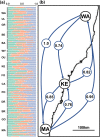The blowfly Chrysomya latifrons inhabits fragmented rainforests, but shows no population structure
- PMID: 36773072
- PMCID: PMC10038970
- DOI: 10.1007/s00442-023-05333-w
The blowfly Chrysomya latifrons inhabits fragmented rainforests, but shows no population structure
Abstract
Climate change and deforestation are causing rainforests to become increasingly fragmented, placing them at heightened risk of biodiversity loss. Invertebrates constitute the greatest proportion of this biodiversity, yet we lack basic knowledge of their population structure and ecology. There is a compelling need to develop our understanding of the population dynamics of a wide range of rainforest invertebrates so that we can begin to understand how rainforest fragments are connected, and how they will cope with future habitat fragmentation and climate change. Blowflies are an ideal candidate for such research because they are widespread, abundant, and can be easily collected within rainforests. We genotyped 188 blowflies (Chrysomya latifrons) from 15 isolated rainforests and found high levels of gene flow, a lack of genetic structure between rainforests, and low genetic diversity - suggesting the presence of a single large genetically depauperate population. This highlights that: (1) the blowfly Ch. latifrons inhabits a ~ 1000 km stretch of Australian rainforests, where it plays an important role as a nutrient recycler; (2) strongly dispersing flies can migrate between and connect isolated rainforests, likely carrying pollen, parasites, phoronts, and pathogens along with them; and (3) widely dispersing and abundant insects can nevertheless be genetically depauperate. There is an urgent need to better understand the relationships between habitat fragmentation, genetic diversity, and adaptive potential-especially for poorly dispersing rainforest-restricted insects, as many of these may be particularly fragmented and at highest risk of local extinction.
Keywords: Diptera; Ecology; Genetic structure; Habitat fragmentation; Rainforest.
© 2023. The Author(s).
Conflict of interest statement
The authors have no conflicts of interest to declare.
Figures






Similar articles
-
Lack of genetic structure among ecologically adapted populations of an Australian rainforest Drosophila species as indicated by microsatellite markers and mitochondrial DNA sequences.Mol Ecol. 2007 Apr;16(8):1687-700. doi: 10.1111/j.1365-294X.2006.03200.x. Mol Ecol. 2007. PMID: 17402983
-
Mapping biodiversity and setting conservation priorities for SE Queensland's rainforests using DNA barcoding.PLoS One. 2015 Mar 24;10(3):e0122164. doi: 10.1371/journal.pone.0122164. eCollection 2015. PLoS One. 2015. PMID: 25803607 Free PMC article.
-
Responses of seed-dispersing birds to amount of rainforest in the landscape around fragments.Conserv Biol. 2014 Apr;28(2):551-60. doi: 10.1111/cobi.12236. Epub 2014 Feb 18. Conserv Biol. 2014. PMID: 24548306
-
South American palaeobotany and the origins of neotropical rainforests.Philos Trans R Soc Lond B Biol Sci. 2004 Oct 29;359(1450):1595-610. doi: 10.1098/rstb.2004.1531. Philos Trans R Soc Lond B Biol Sci. 2004. PMID: 15519975 Free PMC article. Review.
-
Human behaviour and climate-linked fluctuations in the rainforests of West-Central Africa.Philos Trans R Soc Lond B Biol Sci. 2022 Apr 25;377(1849):20200488. doi: 10.1098/rstb.2020.0488. Epub 2022 Mar 7. Philos Trans R Soc Lond B Biol Sci. 2022. PMID: 35249382 Free PMC article. Review.
Cited by
-
Population structure and interspecific hybridisation of two invasive blowflies (Diptera: Calliphoridae) following replicated incursions into New Zealand.Ecol Evol. 2024 Jan 7;14(1):e10832. doi: 10.1002/ece3.10832. eCollection 2024 Jan. Ecol Evol. 2024. PMID: 38192906 Free PMC article.
-
Lords of the flies: dipteran migrants are diverse, abundant and ecologically important.Biol Rev Camb Philos Soc. 2025 Aug;100(4):1635-1659. doi: 10.1111/brv.70017. Epub 2025 Apr 1. Biol Rev Camb Philos Soc. 2025. PMID: 40165599 Free PMC article. Review.
References
-
- Bateta R, Saarman NP, Okeyo WA, Dion K, Johnson T, Mireji PO, Okoth S, Malele I, Murilla G, Aksoy S, Caccone A. Phylogeography and population structure of the tsetse fly Glossina pallidipes in Kenya and the Serengeti ecosystem. PLOS Neglect Trop D. 2020 doi: 10.1371/journal.pntd.0007855. - DOI - PMC - PubMed
MeSH terms
LinkOut - more resources
Full Text Sources

